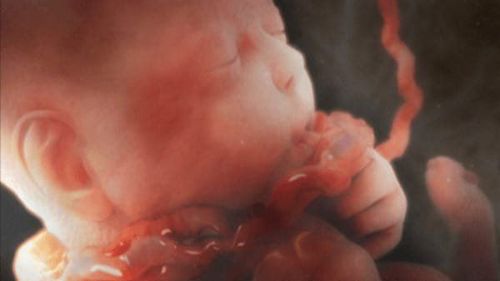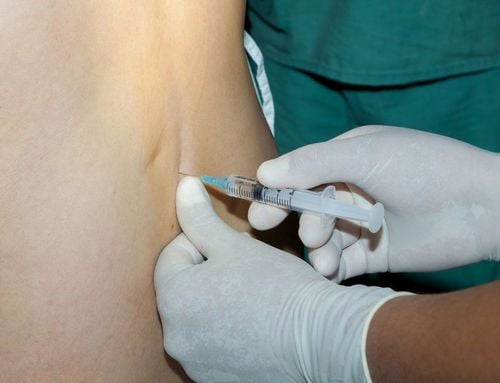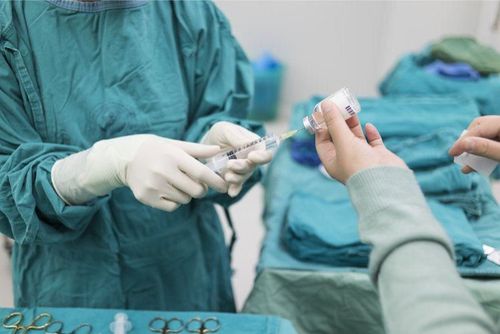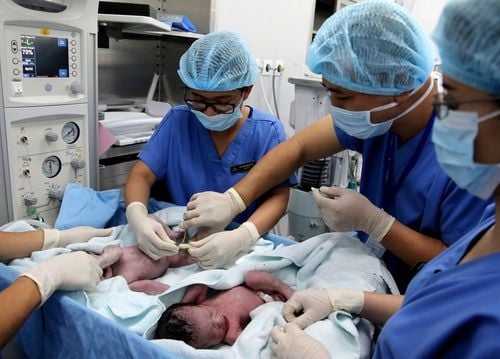This is an automatically translated article.
The article is professionally consulted by Master, Doctor Ta Quang Hung - Department of General Surgery - Vinmec International General Hospital Da Nang.Cesarean section is a modern delivery method, in which, pregnant women are given general anesthesia for resuscitation surgery, and vital signs are monitored during cesarean section anesthesia and postoperatively.
1. Principles of cesarean section anesthesia
Anesthesia for cesarean section is a method of applying anesthesia techniques: general anesthesia, anaesthesia, and resuscitation to carry out surgery to remove the baby through the abdomen. This is a modern method of giving birth, but it also carries many risks, especially when under anesthesia. Therefore, the selection of an anesthetic method should be cautious and must ensure the following principles:Prioritize regional anesthesia because general anesthesia has a higher risk of death. Identifying risk factors and difficulties in controlling airways before intubation for patients with indications for cesarean section based on assessment scales and indicators, in order to minimize the risk of complications. complications, complications. Prevent the risk of aspiration of gastric juice by taking medicines that neutralize stomach acid. If general anesthesia is required, a Sellick procedure should be performed to prevent the reflux of food and gastric juices into the lungs, causing complications of aspiration pneumonia. Ensure and maintain the mother's hemodynamics, placental circulation by treating high blood pressure in patients with high blood pressure: eclampsia, pre-eclampsia.... Release of inferior vena cava compression causing severe hypotension after spinal anesthesia for cesarean section. Maintenance of uterine contractions Patients should take prophylactic antibiotics or appropriate antibiotic therapy to avoid infectious complications. Prophylactic treatment of thromboembolism in high-risk women.
2. C-section anesthesia techniques
Anesthesia techniques in cesarean section include:Regional anesthesia (including spinal and epidural ) General anesthesia Of the techniques above, regional anesthesia is often recommended because of the The following advantages:
Regional anesthesia is safer than general anesthesia: The risk of intubation failure in pregnant patients is 8 times higher than in normal patients. Avoid the risk of aspiration of gastric juices Early recovery of bowel movements After cesarean section, pregnant women have better pain relief and quickly return to normal activities.

Time from anesthesia to surgery Quick technique (< 5 minutes). The technique of anesthesia is simple and easy to perform. Good sensory and motor blockade. Less use of anesthetics. Low cost. However, in addition to the above advantages, spinal anesthesia also has some disadvantages as follows:
Often causes hypotension, slow pulse due to sympathetic inhibition more than epidural, leading to patients feeling nausea, vomiting, shortness of breath, fatigue, respiratory failure ... Contraindicated spinal anesthesia for cesarean section for pregnant women who refuse or have disorders of blood coagulation, hemostasis, or taking medication anticoagulation, bacteremia or infection at the needle puncture site, pregnant women with acute fetal distress, severe obstetric diseases: placental abruption, eclampsia, severe preeclampsia, central placenta previa bleeding Blood, Allergy to anesthetics... The technique of epidural anesthesia for cesarean section is carried out as follows:
Install monitoring devices: Heart rate, BP, SpO2, breathing rate Oxygen breathing 3l/min. Insert a peripheral intravenous line with 18 - 20G needles, using Ringerfundin warm solution or Ringerlactate. Make sure the infusion line is flowing well. Maternity position: You can lie on your side or sit. General Manager: Wash hands, wear clothes, wear sterile gloves. Disinfect the numbed area with 2% Betadine or chlorhexidine solution. Sterile sheets. Anesthesia at the site of anesthesia: L3-L4 lumbar vertebrae. Local anesthetic: mix local anesthetic 1 in 2 ways + 6.5-9 mg Levobupivacaine plain 0.5% + 30 mcg Fentanyl or 3 mcg Sufentanyl.
+ 6-8mg Marcaine heavy 0.5%+ 30 mcg Fentanyl or 3 mcg Sufentanyl.
Assess the extent of anesthesia spreading to the upper part by reflex loss of hot and cold sensation.
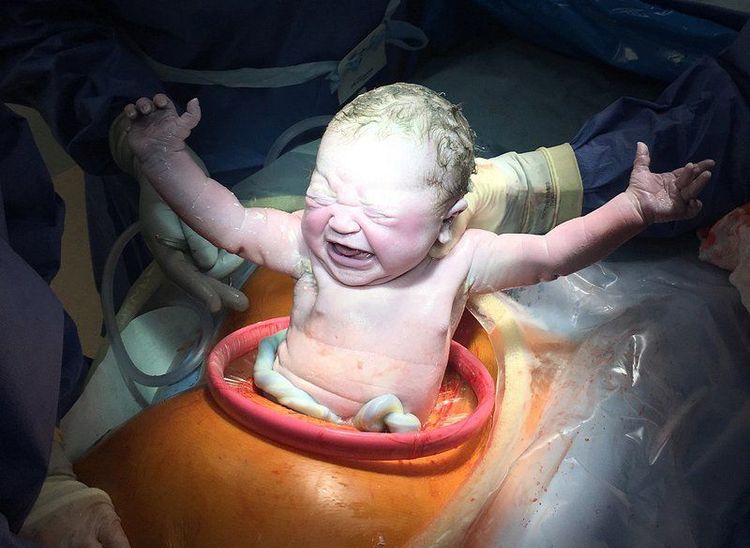
2.3 General anesthesia Although less selective than regional anesthesia, mandatory general anesthesia is indicated for emergency cases of cesarean section as follows:
Maternity delivery by cesarean section. Failure of spinal anesthesia for cesarean section. Some maternity diseases such as: central placenta previa, eclampsia... Emergency surgery such as: acute fetal distress, placental abruption, placental prolapse, uterine rupture... Some diseases that produce pregnancy Women who are difficult to cooperate in surgery such as: History and or being treated for epilepsy, mental retardation... The mother does not agree to have anesthesia. Anesthesia allergy. Infection of the needle puncture area, blood clotting disorder General anesthesia technique is performed including the following steps:
Step 1: Pre-anesthesia Step 2: Initiating anesthesia Step 3: Maintain anesthesia Step 4: After the umbilical cord Step 5: Escape from anesthesia During cesarean section with general anesthesia, attention should be paid to:
Reassure the mother in cases of fetal distress, requiring a quick operation. Take at least 2 intravenous lines in cases of high risk of bleeding due to emergency surgery such as uterine rupture, placenta previa, severe blood loss, embolism due to amniotic fluid, ... Use oxygen therapy 100% for 3 minutes or max. Suction machines and facilities must be available for difficult intubation. Anesthesia must be deep enough. Pay attention to monitor SpO2, - capillary oxygen saturation, EtCO2 - CO2 concentration at the end of exhalation Prevention of gastric reflux complications.
3. Pain relief and care after cesarean section

3.1 Pain relief In the operating room + Catheter to relieve pain in the incision
+ Painkiller: 200 - 240ml Anaropin 0.2% + 8mg Dexamethasone, used in automatic continuous pump at the rate of 4 - 5ml/h.
+ Time: start running analgesia 30 minutes after anesthesia of the lumbar sphincter, continuously up to 48 hours after surgery.
In the recovery room + Anesthesia of the lumbar square muscle (QL block) on both sides. For pregnant women with epidural anesthesia (NMC) cesarean section, the lumbar squamous muscle anesthesia is performed 02 hours after the last dose of local anesthetic.
+ In the case of anesthesia for cesarean section, in addition to placing the catheter, the patient will be anesthetized by the lumbar squamous muscle before the anesthesia is released.
+ Anesthetic: Levobupivacain 0.5% (Chirocaine) or Ropivacain 0.5% (Anaropin) combined with 2 mg of Dexamethasone each.
In the ward + Patient is assessed for pain according to regulations
+ Using drugs: Can use 1 type (if the mother has a surgical incisional analgesia) or 2 drugs (if the mother does not have an incisional catheter) down here.
Paracetamol: 500mg-1000mg/time x 4 times/day. Oral or IV Ibuprofen (gofen 400mg): Take 1 tablet x 4 times/day Or Diclofenac (Voltaren) 50mg: Take 1 tablet x 4 times/day. Or Diclofenac (Voltaren) 100mg: rectally 1 tablet/time x 1 time/day. In case the patient is still in pain, it can be rescued by oral Ultracet or intravenous Tramadol, or by repeated anesthesia of the lumbar squamous muscle.
3.2 Care after cesarean section After cesarean section 4-6 hours, pregnant women can drink sugar water, or eat soup or porridge. On the first day after surgery, women continue to eat porridge or soup until bowel movements are normal. The purpose of early eating is to help the mother's bowel movements to recover soon, to take medicine after cesarean section, and to increase breast milk secretion for breastfeeding. Remove urinary catheter early, exercise early to avoid complications after surgery. Monitor and evaluate the post-operative status of pregnant women with signs: hemodynamic stability, effects of anesthetics, effective pain relief, timely identification and detection of complications for treatment if any. Anesthesia resuscitation in cesarean section is indicated in cases where a normal delivery is not possible, fetal distress and maternal complications.
Anesthesia and resuscitation techniques are applied at Vinmec International General Hospital to help pregnant women experience painless, gentle labor successfully. At Vinmec, there is a team of experienced and professional anesthesiologists who will help pregnant women experience a safe, painless delivery and minimize dangerous complications.
Master. Doctor Ta Quang Hung has more than 10 years of experience in teaching and practicing in the field of Anesthesia and Resuscitation. Currently, he is an Anesthesiologist, General Surgery Department - Vinmec International Hospital Da Nang.
Please dial HOTLINE for more information or register for an appointment HERE. Download MyVinmec app to make appointments faster and to manage your bookings easily.





